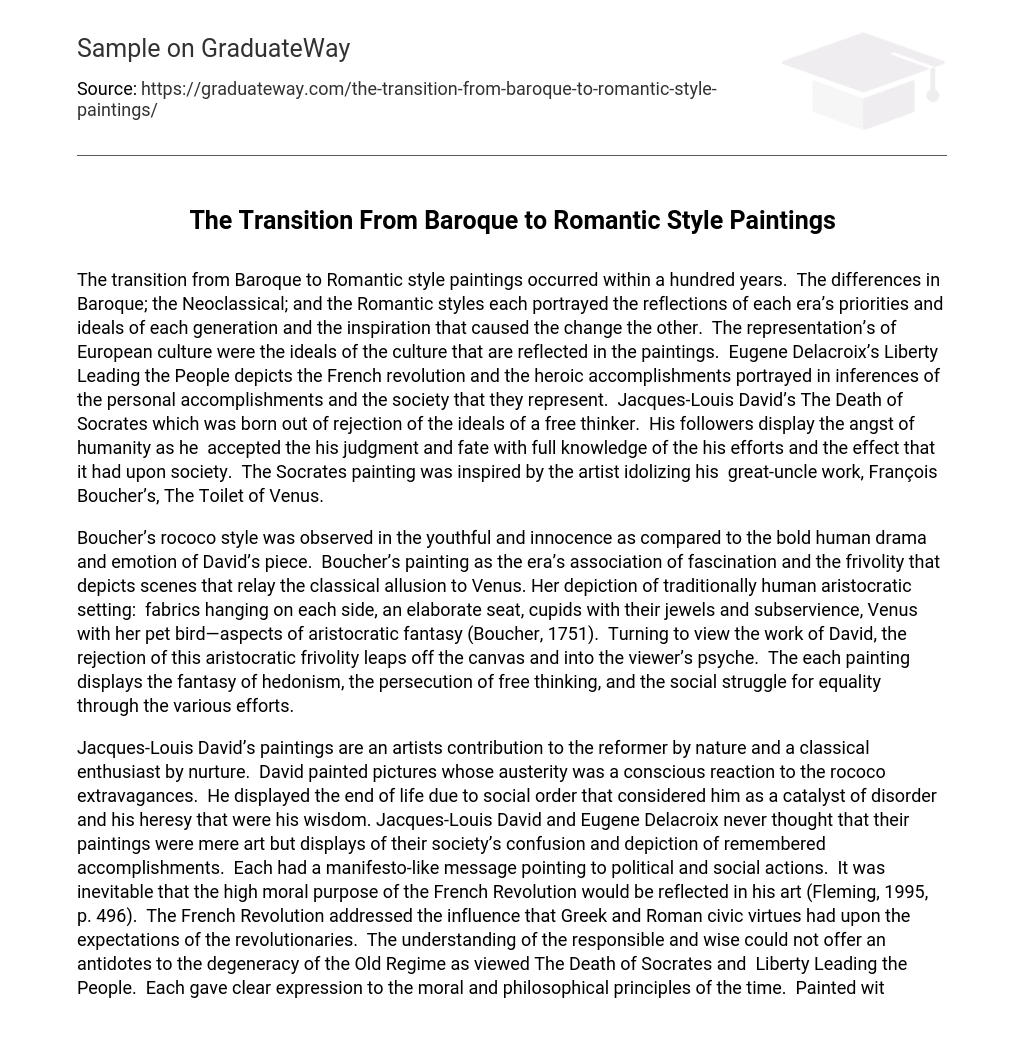The transition from Baroque to Romantic style paintings occurred within a hundred years. The differences in Baroque; the Neoclassical; and the Romantic styles each portrayed the reflections of each era’s priorities and ideals of each generation and the inspiration that caused the change the other. The representation’s of European culture were the ideals of the culture that are reflected in the paintings. Eugene Delacroix’s Liberty Leading the People depicts the French revolution and the heroic accomplishments portrayed in inferences of the personal accomplishments and the society that they represent. Jacques-Louis David’s The Death of Socrates which was born out of rejection of the ideals of a free thinker. His followers display the angst of humanity as he accepted the his judgment and fate with full knowledge of the his efforts and the effect that it had upon society. The Socrates painting was inspired by the artist idolizing his great-uncle work, François Boucher’s, The Toilet of Venus.
Boucher’s rococo style was observed in the youthful and innocence as compared to the bold human drama and emotion of David’s piece. Boucher’s painting as the era’s association of fascination and the frivolity that depicts scenes that relay the classical allusion to Venus. Her depiction of traditionally human aristocratic setting: fabrics hanging on each side, an elaborate seat, cupids with their jewels and subservience, Venus with her pet bird—aspects of aristocratic fantasy (Boucher, 1751). Turning to view the work of David, the rejection of this aristocratic frivolity leaps off the canvas and into the viewer’s psyche. The each painting displays the fantasy of hedonism, the persecution of free thinking, and the social struggle for equality through the various efforts.
Jacques-Louis David’s paintings are an artists contribution to the reformer by nature and a classical enthusiast by nurture. David painted pictures whose austerity was a conscious reaction to the rococo extravagances. He displayed the end of life due to social order that considered him as a catalyst of disorder and his heresy that were his wisdom. Jacques-Louis David and Eugene Delacroix never thought that their paintings were mere art but displays of their society’s confusion and depiction of remembered accomplishments. Each had a manifesto-like message pointing to political and social actions. It was inevitable that the high moral purpose of the French Revolution would be reflected in his art (Fleming, 1995, p. 496). The French Revolution addressed the influence that Greek and Roman civic virtues had upon the expectations of the revolutionaries. The understanding of the responsible and wise could not offer an antidotes to the degeneracy of the Old Regime as viewed The Death of Socrates and Liberty Leading the People. Each gave clear expression to the moral and philosophical principles of the time. Painted with oil on canvas was the only medium that could capture such stoic themes. The Death of Socrates is the perfect example of any Neoclassical statement and the Death of Socrates uses artistic liberty to dramatize the event with the disregard to social conformity. Both David’s neoclassical painting and Plato’s literary work depicts the closing moments of the life of Socrates. After the elderly philosopher was accused by the Athenian government of impiety and corrupting the young through his teachings which aroused skepticism and impiety in his students. He was offered the choice of renouncing his beliefs or being sentenced to death for treason. David shows Socrates calmly discoursing on the immortality of the soul with his grief-stricken disciples, creating an iconographical image that quickly became a symbol of republican virtue and a manifesto of the Neoclassical style (David, 1787).
Completing the evolution from an aristocratic control to democracy was Delacroix and Liberty Leading the People. The dramatic image of the bare-breasted female figure of liberty carrying a flag and urging on revolutionary citizen soldiers seems to be the final blow to the aristocratic ideals as seen in the work of Boucher. The many soldiers that stood around the idolism of liberty are from various classes and the representation that revolutionary and democratic virtues had upon every sector of society (Delacroix, 1830). The transition of idealized serene scenes metamorphosis by personal inferences of aristocratic decadence, and became mediums of the virile anger of common people and their refusal to be oppressed.
In just a few generations, the political state of Europe changed dramatically, as reflected in the art of Delacroix, David, and Boucher. While all the pictures depict virtues of the culture that produced them, they also reflect the diminishing power of the monarchy in Europe. Delacroix’s portrayal of revolution would not have been possible without the republican ideals as seen in the work of David. These painter’s focus on human society was inspired by the thought than painters could still create the aristocratic art and convey the societal perceptions. The sacrifice of a human life for moral principles is far more intriguing than an ancient goddess at leisure with her servants. The morals of hierarchy are expressed well in Liberty Leading the People and The Death of Socrates. The dynamic figures and dramatic light express strong emotion and make it easy to understand why the consideration of a transitional figure between classicism and romanticism.





